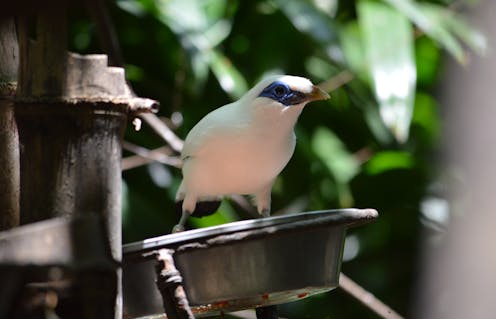
Not all animals are the same. Even within a species, some are bolder and better at solving problems than others. We have found this to be true in the case of the critically endangered Bali myna, a rare bird found only on the island of Bali in Indonesia.
Fewer than 50 adult Bali mynas remain in their native dry forest and savanna on the island. Conservationists are trying, with mixed results, to reintroduce more birds to boost the wild population.
Understanding how each animal perceives, processes, stores and acts upon information (what scientists describe as “cognition”) could determine how successful these efforts are. In fact, the future of many threatened species could depend upon it.
These birds will need to navigate villages, farms and other landscapes dominated by people and recognise food and good places to nest while avoiding a range of predators and other hazards. Their mission is to survive, thrive and breed successfully.
Our research has started to identify the characteristics that make individual Bali mynas most suitable for this task, and so, help conservationists select the best candidates for release into the wild.
We tested how 22 Bali mynas in three UK zoos responded to jelly, a food they had never encountered before, and strange objects placed next to familiar food that makes up their daily diet, including fruit and insects.
We also gauged each bird’s ability to solve problems, such as lifting a lid or pulling a string to reach hidden worms. How each bird behaved indicated which were most adaptable and may be most likely to succeed while navigating new environments.
We found birds took longer to touch familiar food when an item they had never seen before was present. This fear of novelty was more pronounced in adult birds than juveniles, but the birds were quicker to approach new food and objects when other species such as white-spotted laughing-thrushes or lilac-breasted rollers were in their aviaries, suggesting they can overcome fear when competing for food.
While individual birds behaved differently from one another, they reacted consistently to several types of unfamiliar food and objects. It was the bolder birds who were quicker to solve each new problem-solving task, suggesting they may be more adaptable once released too.
How this benefits conservation
Many animal species are threatened with extinction due to habitat destruction, poaching and pollution, among other threats. Returning species to environments they once occupied can help counteract these losses.
But such reintroductions often fail, as many animals raised in captivity struggle to find food, adapt to changing habitats, recognise predators and breed. In fact, 30% of reintroductions have ran into problems due to the behaviour of the animals themselves.
How an animal makes a decision like where to build a nest, how easily they adapt their behaviour to new circumstances and how they learn, including from other animals (both within and outside their own species) are all important criteria for assessing how promising each one is for leading the return of their species to the wild.
We learned which Bali mynas are likely to be best suited for release: typically the bolder or more cautious birds, suggesting two different, but ultimately successful survival strategies.
But this sort of research can also note how each animal behaves once in the wild to better prepare animals for coping once released. Some individuals respond more flexibly to new or changed environments than others.
For instance, bolder captive swift foxes are less likely to survive after release than more cautious foxes, potentially as they are less likely to avoid predators, other competitive animals or risky items left by people, such as traps.
These insights can help conservationists train animals to recognise and respond appropriately to threats like predators and to find safe food or places to breed. Research has shown that pre-release training of ʻAlalā (Hawaiian crows, which are categorised as extinct in the wild) helps the birds learn what to do if they encounter a predator like the Hawaiian hawk in a forest.
Being able to measure the impact of these efforts can tell us whether they improve survival rates. So far, the evidence is promising.
Work with juvenile black-tailed prairie dogs showed that using experienced adults in predator training enhanced their long-term survival post-release.
Limits to what animals can adapt to
The race to reintroduce species is accelerating. Rapid changes in how land is used, from forest to farmland or suburban neighbourhoods for instance, are eclipsing the growth of natural habitats.
Understanding how different animals respond to pressures like urbanisation and applying this to conservation is important. But there are limits to what even the most adaptable animals can overcome, and certain pressures diminish advantageous traits like being a quick learner.
Research on the invasive common myna in Australia showed birds living in towns and cities were more opportunistic foragers and less fearful of predators and also quicker to solve simple problems than those found in rural areas.
But urban noise pollution, like the sound of traffic, has been found to impair learning and memory as well as sleep in rodents and Australian magpies.
By joining forces to combine efforts and insights across research, conservation and education, people in different fields can work together to better improve the chances of protecting the natural world.
Stuart Marsden receives funding from EAZA, Chester Zoo and the Silent Forest Campaign.
Elias Garcia-Pelegrin and Rachael Miller (Harrison) do not work for, consult, own shares in or receive funding from any company or organisation that would benefit from this article, and have disclosed no relevant affiliations beyond their academic appointment.
This article was originally published on The Conversation. Read the original article.







